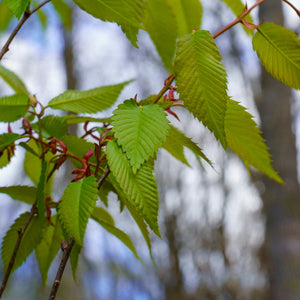The Zelkova Guide
Zelkova (Zelkova serrata) is a deciduous tree valued for its graceful vase-shaped form, attractive peeling bark, and resilience in urban and suburban landscapes. A member of the elm family (Ulmaceae), zelkova is often planted as a replacement for American elm due to its similar silhouette and greater resistance to Dutch elm disease. With fast growth, excellent adaptability, and minimal maintenance requirements, zelkova makes an ideal street, shade, or specimen tree.
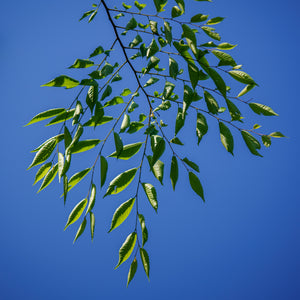
About
Native to Japan, Korea, and Taiwan, Zelkova serrata has naturalized well in the United States and is widely used in public and private landscapes. Its broad crown, smooth gray bark that exfoliates with age, and finely serrated green leaves that turn yellow, copper, or deep red in fall contribute to its ornamental value.
Popular cultivars include:
- ‘Green Vase’: A fast-growing variety with an upright vase-shaped habit and deep green foliage that turns copper-red in fall. It grows to 60–70 feet tall.
- ‘Village Green’: Known for darker green leaves and more spreading habit, with vibrant orange to rust fall color.
- ‘Musashino’: A narrow, columnar form ideal for tight spaces and urban plantings.
- ‘Variegata’: Features leaves with creamy margins and a more refined, ornamental appearance.
Zelkova is prized for its toughness—it tolerates air pollution, urban soils, and drought once established. It also withstands pruning well, making it easy to maintain in restricted or structured spaces.
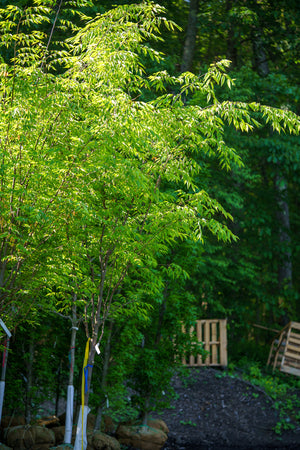
PLANTING
USDA Hardiness Zones: 5–8. Zelkova performs well in a range of temperate climates.
Soil: Prefers moist, well-drained loamy soil but tolerates clay, sand, and compaction. Avoid overly wet or poorly drained sites.
Sunlight: Requires full sun (6+ hours daily) for best growth, canopy development, and fall color.
Watering: Water regularly during the first two to three years. Once established, zelkova is moderately drought tolerant.
Spacing: Plant at least 30–40 feet apart for large shade trees. Narrow forms like ‘Musashino’ can be spaced closer depending on site goals.
Planting Time: Spring or fall is ideal. Avoid midsummer heat or hard winter conditions when planting.
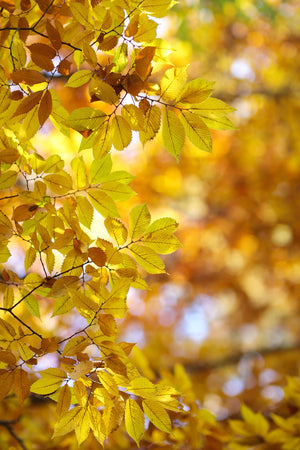
CARE
Watering: Deep, infrequent watering encourages deep root systems. During droughts, provide supplemental watering for best performance.
Fertilizing: Feed in early spring with a balanced tree fertilizer if needed, especially in poor or compacted soils.
Pruning: Prune in late winter to early spring to maintain strong branching structure and remove any crossing, damaged, or weak limbs. Zelkova responds well to structural pruning in youth.
Pests and Diseases: Zelkova is relatively disease-free. Occasional pests include aphids or scale, but serious infestations are rare. Dutch elm disease does not affect zelkova.
Mulching: Apply a 2–3 inch mulch ring around the base to conserve moisture, moderate soil temperature, and protect from mower damage. Keep mulch away from the trunk.
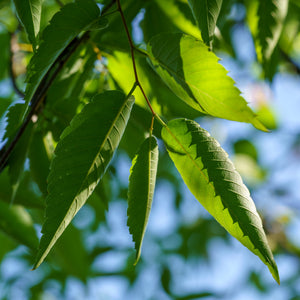
HOW TO USE
Shade Tree: Zelkova’s spreading canopy makes it an excellent choice for providing summer shade over patios, lawns, or driveways. ‘Green Vase’ and ‘Village Green’ are especially effective in this role.
Street and Boulevard Tree: Tolerant of urban stressors, zelkova is widely planted along city streets, medians, and sidewalks. The vase shape mirrors the American elm while avoiding susceptibility to disease.
Narrow Urban Sites: Use upright varieties like ‘Musashino’ where horizontal space is limited but vertical height is needed.
Specimen Tree: Zelkova’s exfoliating bark and fall color make it an attractive focal point in large lawns or commercial landscapes.
Campus and Park Trees: Their durability, ease of maintenance, and broad shade make zelkovas a favorite for institutional planting projects.
Mixed Tree Lines: Use alongside ginkgo, honeylocust, or red maple for visual contrast and seasonal diversity.
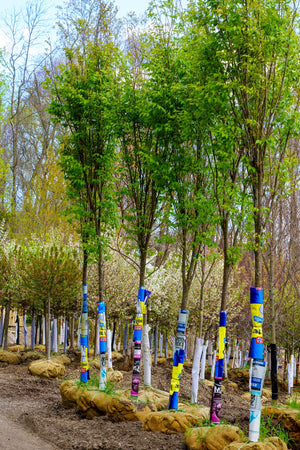
Common Questions
How fast do zelkova trees grow? Zelkova has a moderate to fast growth rate, typically growing 1 to 2 feet per year under ideal conditions.
What does a zelkova tree look like? It has a tall, vase-like structure with upward-arching branches, smooth gray bark that flakes with age, and finely toothed green leaves that turn brilliant colors in fall.
When do zelkova trees bloom? Zelkova produces inconspicuous greenish flowers in early spring. They are wind-pollinated and not considered showy.
Are zelkova trees hardwood? Yes. Zelkova is a hardwood species known for strong, durable timber, historically used for furniture and carving.
Are zelkova trees native? No, they are native to East Asia but have been widely planted and naturalized in North America as landscape trees.
How big do zelkova trees get? Most cultivars reach 50–70 feet tall and 40–60 feet wide at maturity. Compact or upright varieties remain smaller.
How long do zelkova trees live? With proper care, zelkova can live 60 to 100 years or more. They are considered long-lived shade trees.
Do zelkova require full sun? Yes. Full sun is necessary for strong structural growth, dense branching, and optimal fall color.
Conclusion
Zelkova trees are among the most dependable and attractive choices for modern landscapes. With a graceful form, resistance to pests and diseases, and adaptability to urban environments, Zelkova serrata is a powerful alternative to American elm and a top choice for shade, structure, and seasonal beauty. Whether you're planting a street tree or a standout lawn specimen, zelkova delivers strength, elegance, and longevity in every season.
The Zelkova Collection
Sold Out
Sold Out

